Samsung Droid Charge Review - Droid Goes LTE
by Brian Klug on June 22, 2011 7:47 AM EST- Posted in
- Smartphones
- Samsung
- LTE
- 4G
- Droid Charge
- Mobile
Display
Of course one of the most compelling features of the Charge is the 4.3” Super AMOLED Plus display. We’ve talked about Super AMOLED before - for a quick refresher, SAMOLED is simply an AMOLED panel with the display, digitizer, and top glass bonded using optical adhesive. Every time light encounters an air-glass interface, a certain amount of light is reflected, usually around 4%. That adds up fast when you consider that each contributes to glare, less light making it out, and additional thickness, with each incurring a transmission loss and back reflection. Optically bond the entire thing together, and the stack behaves like one continual piece of glass instead of three separate pieces. That’s the “Super” in Super AMOLED.
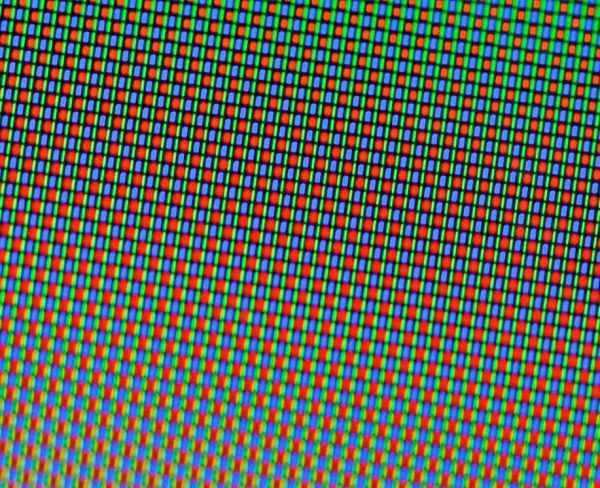

Left: Samsung Galaxy S with RG-BG PenTile subpixel layout (Super AMOLED), Right: Droid Charge with RGB stripe subpixel layout (Super AMOLED Plus)
The next part is Plus. Both Super AMOLED and the original AMOLED use a PenTile subpixel rendering layout. Instead of 3 subpixels per pixel (RGB), AMOLED uses sets of 2 subpixels per pixel (RG-BG) to create the perception of the same effective resolution of an RGB stripe. The result is better informational efficiency - fewer subpixels to convey the perception of the same image. RG-BG PenTile is great in practice for things with organic structure, and not good for one pixel thick graphics, lines, or UI elements. Unfortunately, that includes text. Note that RGBW PenTile for LCD displays actually renders text brilliantly, but that’s a discussion for the Droid X2 review.
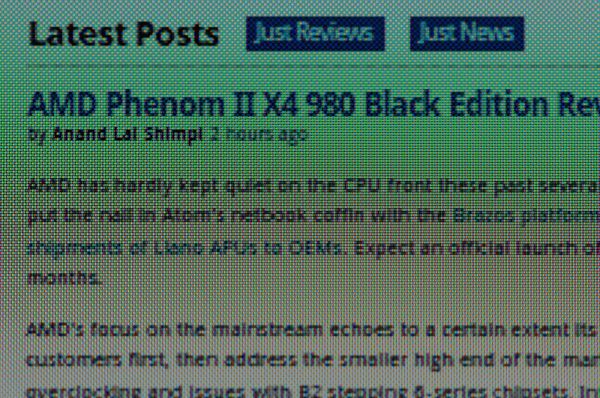
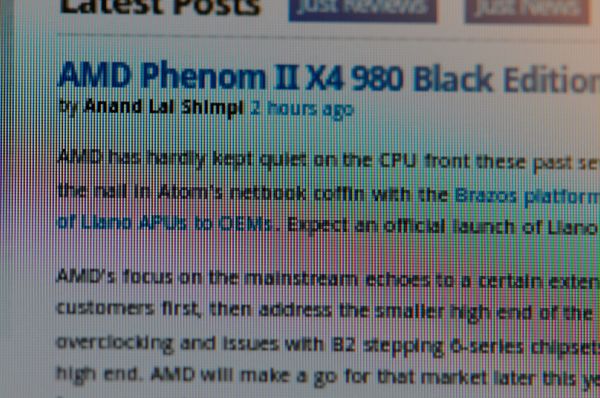
Left: 100% zoom of Super AMOLED, Right: 100% zoom of Super AMOLED Plus (note that the color banding is aliasing from the camera sensor sampling)
As a result, Samsung has moved on from PenTile and introduced Super AMOLED Plus which brings all the benefits of an AMOLED display (blacks that are completely off, power savings on black, effectively infinite contrast, e.t.c.) with a full 3 subpixel per pixel RGB stripe that renders text and one pixel thick UI elements without any loss of resolution.
Subpixel layouts aren’t of course all there are to talk about with Super AMOLED Plus. One of the things original AMOLED was often criticized for having was saturated colors, and rendering white with a definite blue cast. Moreover, one of my chief complaints has been that it used to seem like white point wasn’t stable across the brightness scale on older panels. We’re going to do display brightness reporting a bit differently from now on. Instead of just measuring at the maximum brightness, we will measure white point, white, and black at 100%, 75%, 50%, 25%, and 0% brightness on the device and report those, so we can track how linear the scale is, and white point. Inside the graph we will still report maximum brightness data.

The display brightness scale on the Charge is nice and linear, almost perfectly so. Unfortunately it appears that Super AMOLED Plus still retains a slightly blueish cast as evidenced by color temperature above and around 8500K. Contrast still is as impressive as we’re used to seeing for AMOLED though, with essentially no reading on blacks due to the pixels being essentially off.
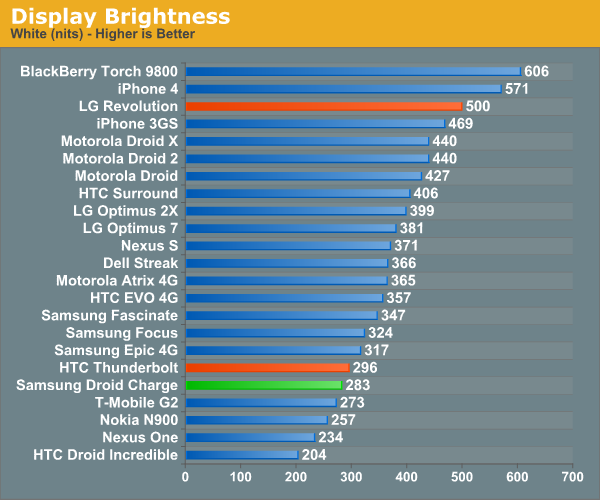
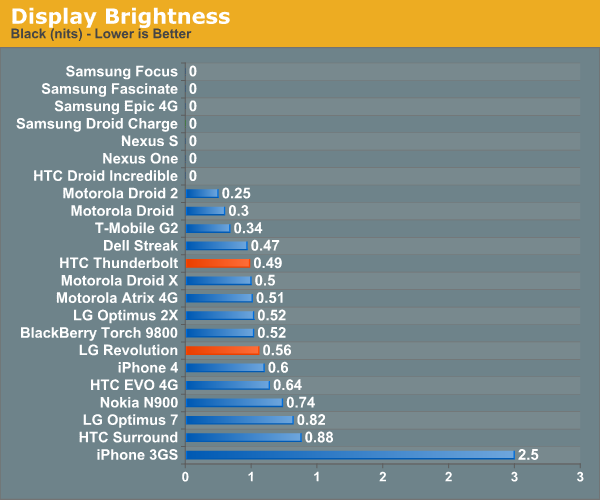
The Charge’s display is exactly the same as what’s being used in the Galaxy S 2 - both are 4.3” WVGA 800x480 SAMOLED+. I feel like 4.3” is as big as one really should go with WVGA, and having seen qHD screens that are the same size, I find myself wishing that Samsung somehow had been able to make a qHD SAMOLED+ display. Alas, one can’t have one’s cake and eat it too, at least not yet.
Viewing angles on the Charge’s SAMOLED+ display are also stellar, there’s virtually no color distortion as you move to extreme angles horizontally or vertically. It simply falls off to zero as you exceed some critical angle at the most extreme of angles, and that’s a good thing.
That said, I do have a problem with SAMOLED+ right now, one that I didn’t notice ever with any other SAMOLED or AMOLED display. The problem is especially severe in my climate, where at the time of this writing it’s literally 110 F (43 C) outside - overheating.
I’ve carried the Charge around for some time now, and noticed that when I spend lots of time outside using it in the sun, or leave it on my dashboard for navigation, the device will overheat and restrict maximum brightness to a little over half. As a result, display brightness is restricted right when you need it the most. If you let things get out of hand more, the Charge will disable battery charging to prevent the battery from exceeding safe operating temperatures in addition to keeping the display brightness low.
I’ve had phones on my dashboard, in my pocket, and outdoors in the 110+ F climate here all the time, and never have I experienced this much overheating. I stood outside with the Charge and an IR thermometer and saw this behavior take place when the front glass hit 105 F consistently, which seems a bit low for restricting things, although inside it’s probably substantially warmer. I suspect I’ll see the same SAMOLED+ overheat brightness restrictions kick in with the Galaxy S 2 as well. If you’re in a cool climate, you essentially can ignore this, or if you’re in a warm climate but not going to use the device for Google navigation on your dashboard, this isn’t a huge concern either. However, in climates like mine, it’s a day to day annoyance if you’re outside with the phone in hand for any amount of time. I’m not even an outdoors person (by any stretch of the imagination), and even then I’ve seen the Charge do this little overheat dance a few times already.

















61 Comments
View All Comments
crydee - Wednesday, June 22, 2011 - link
Samsung never updates.. I still have the Galaxy first Android on AT&T and still no working GPS.sprockkets - Wednesday, June 22, 2011 - link
I saw the picture and thought this was a review of the new iphone! Oh my! Now I can see why apple is so angry!GFY JOBS!
spctm - Wednesday, June 22, 2011 - link
Not sure why it is so but I am running Cyanogenmod 7.1 nightly on a nexus one and I get these scores.SunSpider: 3354.2
BrowserMark: 54697
Linpack: 36.7 (Free Version)
Sunspider and Browsermark are way faster on cm-7.1, which is quite surprising as it is running Android 2.3.4 base. But Linpack is more along the lines with what Brian got. Not sure if the free version's ad streaming would have some impact on floating point operations of Linpack.
Just thought I would post this observations and see if others have similar results.
silverblue - Wednesday, June 22, 2011 - link
Looks to be a good phone, though I wonder if it'll be better than the Charge.Omid.M - Wednesday, June 22, 2011 - link
"I have an odd Sensation that the next one will be exciting..."Hah!
Can't wait for the Galaxy S 2 review. Hope it lives up to AT expectations.
@moids
name99 - Wednesday, June 22, 2011 - link
"My only complaint is that every once in a while, the LTE data session sometimes stalls briefly – sometimes for a a few seconds, other times for a few minutes. When that happens, you’ll see the uplink green arrow blink, but no orange downlink arrow. Rebooting the device fixes things.
"
Jesus Christ.
THIS is precisely why Apple has nothing to fear, as long as competitor vendors ship crap like this --- and reviewer web sites are so blinded by Apple hatred that they give them a pass. I mean, WTF --- a phone that you, randomly and frequently, have to reboot, and the reviewer thinks this is just par for the course?
This is 2011, not 1982. Forcing a reboot to fix random problems should be a strange and unusual situation, not a daily occurrence!
ThomasA - Wednesday, June 22, 2011 - link
Long time VZW customer, since GTE. This may change. The future should be interesting with the '4G' push, and now, the 'new' Verizon tiered data plans looming. Having a '4G' device will require either a big wallet or detailed restraint.I suggest using a cheap flip-phone for chit-chat and another device on hotspots (laptop, netbook, iPod touch) for web needs. Unless you enjoy transfusing the telecoms.
sitharien - Wednesday, June 22, 2011 - link
You are both correct, I was way mistaken. I look forward to Anand's review. I am holding off on any upgrade of my EVO 4G until I get a better picture of the Android battery landscape.BGK - Wednesday, June 22, 2011 - link
So what's the verdict on Charge vs Thunderbolt. If battery life is about the same, that leaves the screen as the Charge's major advantage.Also, do you think some of discrepancies in battery life in the reviews had to do with the reviews of the thunderbolt being done on older versions that may have been less efficient?
tdenton1138 - Thursday, June 23, 2011 - link
Visit XDA or Android Central forums. You can read up about both phone for people who use them every day... I love my Charge (every phone does seem to have its quirks) and don't imagine I'll bother upgrading for quite some time. Great screen, no lag (voodoo lagfix is needed here - why does Samsung use RFS filesystem when EXT4 is so much better?), acceptable battery, hackable. Until someone can demonstrate a real need for dual+ core on a phone (now tablets perhaps...?), I'm happily sitting out of the upgrade race for a while.